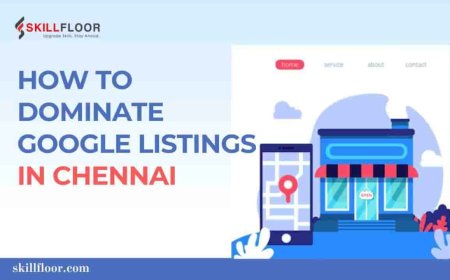The Future of Google Ads: Trends to Watch
Explore the cutting-edge trends shaping the future of Google Ads . Stay ahead of the competition with insights on keywords, AI, automation, and more.

In the ever-evolving landscape of digital advertising, staying informed about the latest Google Ads trends is paramount for advertisers and marketers alike. The importance of remaining up-to-date cannot be overstated, as the digital advertising arena is characterized by its rapid pace of change. New technologies, consumer behaviors, and market dynamics continually reshape the advertising landscape, making it essential for businesses to adapt and leverage emerging trends to maintain a competitive edge.
AI-Powered Campaign Optimization
In the ever-evolving landscape of digital advertising, one trend that stands out prominently is the increasing reliance on artificial intelligence (AI) for campaign optimization. Google Ads, in particular, has harnessed the potential of AI to revolutionize the way advertisers reach their target audiences. AI-powered algorithms can now analyze vast amounts of data in real time, allowing for more precise ad targeting, bidding, and ad creative optimization. This means that campaigns can be fine-tuned with a level of accuracy and speed that would be nearly impossible to achieve manually. As we look forward to the role of AI in Google Ads is set to expand even further, making it imperative for advertisers to leverage these intelligent tools to stay competitive and achieve remarkable results. Whether it's refining your audience targeting, optimizing your ad spend, or crafting compelling ad copy, AI-powered campaign optimization is a trend that's shaping the future of Google Ads.
Privacy-Centric Advertising
Explore the Impact of Privacy Changes (e.g., cookie restrictions) on Google Ads:*
The landscape of digital advertising is undergoing a significant transformation, largely driven by increasing concerns over user privacy. One of the most notable changes is the growing restrictions on cookies, which have traditionally been a crucial tool for tracking user behavior and targeting ads. With browsers like Safari and Firefox already blocking third-party cookies, and Google's Chrome planning to phase them out, advertisers are facing a new reality. These changes impact the way businesses can track and target users, making it essential for Google Ads specialists to adapt and find alternative methods to maintain campaign effectiveness.
Discuss Strategies for Adapting to a More Privacy-Focused Advertising Landscape:
In this evolving privacy-centric landscape, advertisers must rethink their strategies. First and foremost, it's crucial to prioritize transparency and user consent. Informing users about data collection practices and obtaining their consent is not just a legal requirement (as seen in regulations like GDPR and CCPA) but also a way to build trust with your audience. Additionally, consider investing in first-party data collection and analysis. Building a robust database of your own can help you reduce reliance on third-party cookies and maintain personalized advertising.
Furthermore, explore alternative targeting methods like contextual advertising, which focuses on placing ads in the right context rather than relying on individual user data. Contextual targeting ensures that your ads align with the content users are consuming, making them more relevant and less reliant on tracking.
Highlight Google's Privacy Sandbox and Its Implications:
Google has recognized the need for privacy-focused advertising solutions and introduced the Privacy Sandbox initiative. This project aims to create a more private browsing experience while still allowing advertisers to reach their target audiences effectively. It includes technologies like Federated Learning of Cohorts (FLoC), which groups users based on their interests rather than tracking individual behavior.
As a Google Ads specialist, it's essential to stay updated on the developments within the Privacy Sandbox and how they may affect your campaigns. Understanding these tools and adapting your strategies to work within a more privacy-conscious framework will be key to success in the future of Google Ads. Embracing these changes and finding creative ways to maintain ad relevance while respecting user privacy will be crucial for staying competitive in the evolving digital advertising landscape.
Video and Interactive Ads
Video advertising has been on the rise for several years, and , it's expected to take center stage in Google Ads. With the ever-increasing consumption of video content online, advertisers are recognizing the power of video ads for engaging audiences and driving conversions.
-
The Rise of Video Ads: Video ads offer a dynamic way to capture users' attention. Whether it's a short YouTube ad, a video in a display campaign, or a video discovery ad, these formats are highly effective at conveying your message and telling a compelling story. Expect to see more businesses embracing video ads as a core part of their advertising strategy.
-
Interactive Ad Formats: Beyond traditional video ads, interactive ad formats are gaining traction. Interactive ads allow users to engage with the content directly, making the ad experience more immersive. Features like interactive quizzes, polls, and shoppable videos enable users to interact with the ad, providing a more personalized and engaging experience.
-
Mobile Video Advertising: Mobile continues to dominate online user engagement, and video ads are no exception. Mobile video ads, especially on platforms like YouTube and within mobile apps, are expected to grow in popularity. As a Google Ads specialist, it's essential to optimize your video ads for mobile devices, ensuring they load quickly and look great on smaller screens.
-
Performance Metrics: With the increase in video and interactive ad formats, tracking and analyzing performance become crucial. Advertisers will focus on metrics like view-through rate (VTR), engagement rate, and conversion rate to measure the success of their video campaigns. Understanding these metrics will be key to refining your ad strategies.
-
Video Ad Personalization: In expect more emphasis on personalization in video ads. Leveraging user data and insights, advertisers can deliver tailored video content to different audience segments, increasing relevance and engagement. Customizing video ads based on user behavior and preferences can significantly improve campaign effectiveness.
Local Advertising and Micro-Moments
In local advertising is poised to take center stage in Google Ads strategies. The concept of micro-moments, where users turn to their smartphones for quick, immediate answers, is driving this trend. Whether it's finding a nearby restaurant, comparing product prices, or seeking services within their vicinity, users increasingly rely on their mobile devices for on-the-go decisions. As a Google Ads specialist, understanding how to leverage local targeting and micro-moments can be a game-changer. Tailoring your campaigns to meet the immediate needs of users in specific geographic areas can result in higher engagement and conversions. In this section, we'll delve into the significance of local advertising, explore how micro-moments influence user behavior and search intent, and provide you with strategies to harness the power of these moments to your advantage.
Voice Search and Conversational Ads
Voice search has witnessed exponential growth in recent years, thanks to the proliferation of smart speakers like Amazon Echo and Google Home. Users are increasingly using voice commands to search for information, products, and services. This trend is set to continue as more households adopt smart speakers and mobile devices integrate voice assistants like Siri and Google Assistant.
Conversational ads are a dynamic advertising format designed to engage users in real-time conversations. They allow users to interact with ads by asking questions, seeking information, or even making purchases directly within the ad format. The benefits of conversational ads are manifold, including higher user engagement, enhanced customer experiences, and the ability to provide immediate responses to customer inquiries. In future expect conversational ads to become more prevalent as brands aim to foster meaningful interactions with their target audiences.
Insights on Optimizing Ads for Voice Search and Conversation
Optimizing ads for voice search and conversation requires a nuanced approach. To succeed, advertisers need to:
-
Understand User Intent: Recognize that voice search queries often have a more conversational and natural language structure. Tailor your ad content to match these conversational queries.
-
Leverage Long-Tail Keywords: Voice searches tend to be longer and more specific. Incorporate long-tail keywords into your ad campaigns to capture these nuanced search queries.
- Provide Quick Answers: Voice search users often seek immediate answers. Craft ad copy that concisely addresses common questions related to your products or services.
- Implement Structured Data: Use structured data markup on your website to provide clear and structured information that search engines can use to understand your content better.
Sustainability and ESG Advertising
Introduction to Sustainability and ESG Advertising
Sustainability and Environmental, Social, and Governance (ESG) advertising have emerged as powerful trends in the marketing landscape. With growing environmental concerns, social issues, and ethical considerations, consumers are increasingly making choices based on a brand's commitment to sustainability and responsible business practices. In this context, ESG advertising has become a vital tool for brands to communicate their values and initiatives to a socially conscious audience.
The Rise of Sustainability-Driven Campaigns
Over the past few years, we've witnessed a surge in sustainability-driven advertising campaigns. Brands are aligning their marketing efforts with sustainability goals, often emphasizing their environmental and social impact. These campaigns go beyond traditional product promotion and delve into highlighting eco-friendly practices, fair labor standards, and community involvement. They resonate with consumers who want to support businesses that contribute positively to the planet and society.
Strategies for Effective ESG Advertising
Creating effective ESG advertising campaigns requires a thoughtful approach. Brands need to genuinely commit to sustainable practices rather than engaging in greenwashing, which can harm their reputation. Transparency is key; consumers appreciate honesty about a company's journey toward sustainability and any challenges faced. Furthermore, collaborations with nonprofit organizations, supporting causes, and setting clear ESG targets can enhance the credibility of these campaigns. Authenticity and a long-term commitment to ESG principles are essential for success.
Measuring Impact and the Future of Sustainability Advertising
Measuring the impact of sustainability and ESG advertising is crucial. Brands should track key performance indicators related to their sustainability goals and communicate progress honestly. In the future, sustainability advertising is likely to become even more integral to brand identity, as consumers continue to prioritize ethical and eco-conscious choices. Brands that effectively integrate sustainability and ESG into their marketing strategies not only contribute to positive societal and environmental changes but also stand to gain the loyalty of a growing segment of conscientious consumers.
The Google Ads is evolving rapidly with several exciting trends taking center stage. We've explored the impact of AI-powered campaign optimization, the shift towards privacy-centric advertising, the rise of video and interactive ads, the significance of local advertising and micro-moments, the growing influence of voice search and conversational ads, the emergence of sustainability and ESG-focused advertising, the benefits of cross-channel integration, and the power of data-driven creativity. As digital marketers and Google Ads specialists, it's crucial to remain adaptable and well-informed about these trends. Embrace these changes as opportunities to elevate your advertising strategies, connect with your audience on a deeper level, and ultimately achieve greater success in the ever-evolving world of Google Ads.




























































